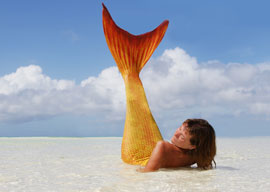
June 04, 2013

Source: Shutterstock
Last week the television channel Animal Planet, which touts itself a primarily educational outlet, ran a program entitled Mermaids: The New Evidence. It featured several supposed experts, allegations of government cover-ups, and some of the worst CGI since Anaconda 3. About the only thing this turkey actually gave evidence of is how incredibly gullible Americans are these days.
Audiences were told that public demand necessitated this pseudoscientific offering. (After all, the Kardashians took time out of busy days shilling products and selling baby photos to Tweet support for the first installment!) Judging by the lamentably high ratings, it seems the public is indeed not very demanding.
I am all for having a good chuckle. Had this been broadcast on April Fool’s Day or Halloween, there would have been an implicit wink and a nod to the viewer. My own radio is annually tuned to hear the rich timbre of Orson Welles speak about Martians every October 31.
A couple decades ago CBS broadcast Without Warning, which purportedly detailed an asteroid impact as a live event. It utilized former news personalities to lend credulity and heighten the faux reality. Even so, both the Welles and CBS “docudramas” prominently featured disclaimers before and after stating that everything contained therein was fake. Not so Animal Planet.
Consequently, several actual scientists decried this de-intellectualization of formerly reliable venues. Counting up the growing list of high-minded brands with lowbrow broadcasting, it is difficult to argue.
We have the History Channel (ghosts and occasionally Nazi ghosts), the Learning Channel (overweight yokels showcasing future carnival acts), Arts & Entertainment (hoarding”a mental disorder neither artistic nor entertaining), and now Animal Planet (mermaids and Finding Bigfoot). As usual, the scientists seem correct in their assessment.
All television has become a parody of reality. For example, how many young women believe The Bachelor plausibly depicts 21st-century courtship rituals? Alas, very many. Once a friend and I watched an installment (my singular viewing) and endeavored to figure the annual income needed to furnish such a lifestyle. Our conclusion was that a man would need approximately $5 million after taxes to live as lavishly as the series presents. That isn’t an entirely implausible until one recalls that half the globe lives on less than $2 per day.
Worse is what one might refer to as trickle-down uneconomics. While in my day it was not unusual for an engagement ring to be set with an opal or sapphire, young ladies today demand diamonds. On several occasions I have heard women state without irony they expect no less than a two-carat ring set in platinum. Leaving aside whether they would even recognize platinum if they saw it, the fact that these are often waitresses, shopgirls, or hairdressers leaves me agape.
Recently YouTube was “forced” (i.e., offended by what people actually think when allowed to speak freely) to close the comments section on a Cheerios commercial with an interracial family. In the advertisement the upper-middle-class couple resides in a spacious home, both of them attired in conservative dress. Is this the reality of interracial couplings? Perhaps for a minuscule minority. Somehow other significant statistics of these pairings never make the screen. That is, unless it’s on the evening news and only then with the headline, “Woman murdered by youth.”